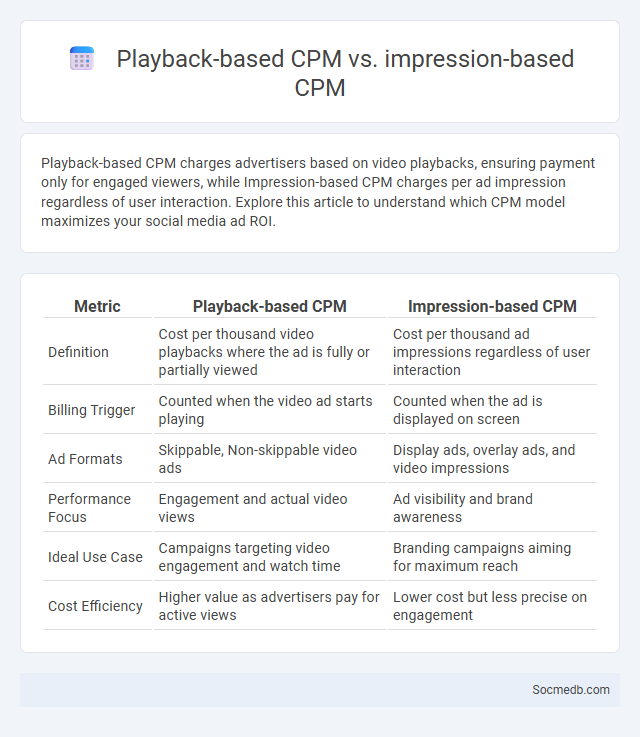
Photo illustration: Playback-based CPM vs Impression-based CPM
Playback-based CPM charges advertisers based on video playbacks, ensuring payment only for engaged viewers, while Impression-based CPM charges per ad impression regardless of user interaction. Explore this article to understand which CPM model maximizes your social media ad ROI.
Table of Comparison
| Metric | Playback-based CPM | Impression-based CPM |
|---|---|---|
| Definition | Cost per thousand video playbacks where the ad is fully or partially viewed | Cost per thousand ad impressions regardless of user interaction |
| Billing Trigger | Counted when the video ad starts playing | Counted when the ad is displayed on screen |
| Ad Formats | Skippable, Non-skippable video ads | Display ads, overlay ads, and video impressions |
| Performance Focus | Engagement and actual video views | Ad visibility and brand awareness |
| Ideal Use Case | Campaigns targeting video engagement and watch time | Branding campaigns aiming for maximum reach |
| Cost Efficiency | Higher value as advertisers pay for active views | Lower cost but less precise on engagement |
Introduction to CPM Models in Digital Advertising
CPM models in digital advertising are crucial for understanding how costs are measured based on impressions delivered, optimizing your advertising budget effectively. Social media platforms like Facebook and Instagram use CPM to charge advertisers per 1,000 views, making it essential to monitor audience engagement and ad placement. Mastering CPM strategies helps you maximize reach and improve return on investment by targeting specific demographics accurately.
Understanding Playback-based CPM
Playback-based CPM measures the cost advertisers pay per 1,000 video views that meet specific playback criteria, such as a minimum watch duration or interaction. This metric ensures advertisers are billed only when users actively engage with the video content, improving campaign efficiency and ROI. Platforms like Facebook and YouTube use playback-based CPM to optimize ad spend by focusing on genuine viewer engagement rather than just impressions.
What Is Impression-based CPM?
Impression-based CPM (Cost Per Mille) measures the cost advertisers pay for every thousand times their ad is displayed on social media platforms, regardless of user interaction. Your campaign's effectiveness can be evaluated by analyzing the number of impressions, helping you understand reach and brand visibility. This metric is crucial for brand awareness strategies where the goal is to maximize exposure rather than clicks or conversions.
Ad Revenue: Definition and Key Metrics
Ad revenue in social media refers to the income generated from advertisements displayed on platforms such as Facebook, Instagram, and Twitter. Key metrics to measure ad revenue include Cost Per Click (CPC), Cost Per Mille (CPM), Click-Through Rate (CTR), and Return on Ad Spend (ROAS). Understanding these metrics empowers you to optimize campaigns for maximum profitability and audience engagement.
Pros and Cons of Playback-based CPM
Playback-based CPM (Cost Per Mille) on social media offers advertisers precise performance tracking by charging based on actual video views, increasing budget efficiency for campaigns targeting high engagement audiences. However, this model may inflate costs during non-interactive views or auto-play scenarios, leading to lower conversion rates and potential overspending. Balancing playback-based CPM requires careful monitoring of view authenticity and audience interaction metrics to optimize return on investment.
Advantages and Drawbacks of Impression-based CPM
Impression-based CPM (Cost Per Mille) offers advertisers the advantage of broad reach and enhanced brand visibility by charging per thousand ad impressions, making it ideal for campaigns focused on awareness rather than direct clicks. However, this model may lead to inefficiencies as you pay regardless of user engagement, potentially resulting in lower ROI if impressions are not targeted effectively. Careful audience segmentation and platform selection are essential to maximize the benefits and minimize the drawbacks of impression-based CPM in your social media strategy.
Comparing Playback-based vs Impression-based CPM
Playback-based CPM measures advertising cost per thousand completed video views, emphasizing viewer engagement by ensuring ads are fully watched, making it ideal for video campaigns targeting active users. Impression-based CPM calculates cost per thousand ad impressions regardless of viewer interaction, focusing on reach and brand visibility across platforms like Facebook and Instagram. Choosing between playback-based and impression-based CPM depends on campaign goals--engagement-driven strategies benefit from playback-based metrics, while brand awareness campaigns align better with impression-based pricing.
Impact of Each Model on Ad Revenue
Different social media models, such as subscription-based, ad-supported, and hybrid platforms, directly influence ad revenue streams by varying user engagement and targeting capabilities. Ad-supported models like Facebook and Instagram rely heavily on user data to optimize personalized advertisements, generating substantial income through scalable ad placements and high user adoption. Subscription-based models, while offering limited ad space, reduce reliance on ads and focus on premium user experiences, which may slow direct ad revenue growth but foster long-term monetization via diversified revenue streams.
Choosing the Right CPM Model for Your Campaign
Selecting the appropriate CPM model for your social media campaign hinges on your objective, whether it's brand awareness, engagement, or conversions. Fixed CPM offers predictable costs for campaigns targeting broad reach, while dynamic CPM adjusts bids in real-time to maximize ad placement efficiency. Understanding platform-specific CPM variations on Facebook, Instagram, or LinkedIn can optimize budget allocation and enhance campaign performance.
Future Trends in CPM and Ad Revenue Optimization
Emerging trends in social media CPMs reveal increasing adoption of AI-driven targeting and programmatic buying, boosting ad revenue through higher engagement rates and precise audience segmentation. Platforms leverage real-time data analytics and machine learning to optimize ad placements, maximizing return on investment by dynamically adjusting bids and content relevance. Enhanced integration of augmented reality ads and influencer partnerships is projected to drive CPM values upward, reshaping monetization strategies across digital channels.
 socmedb.com
socmedb.com